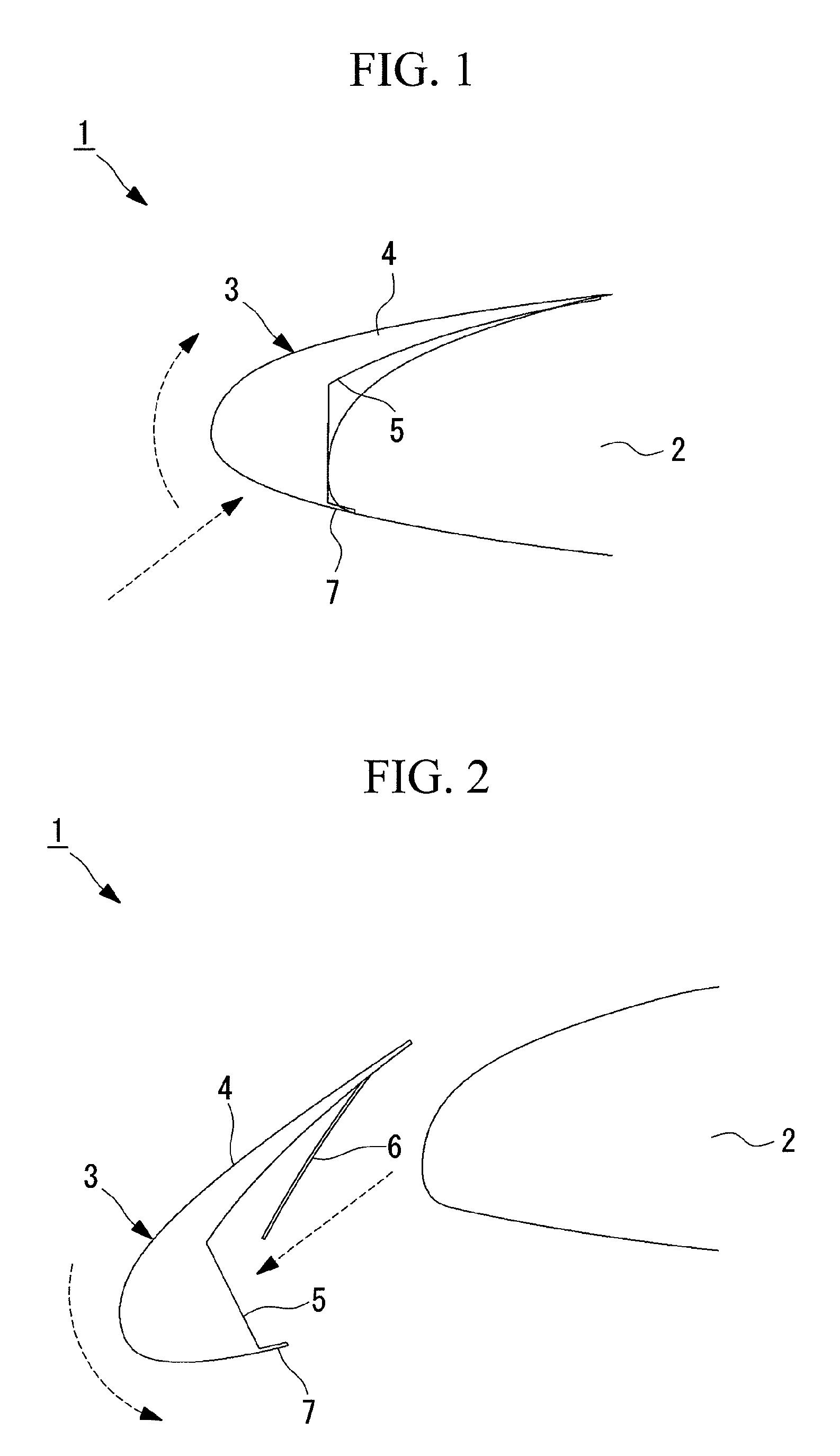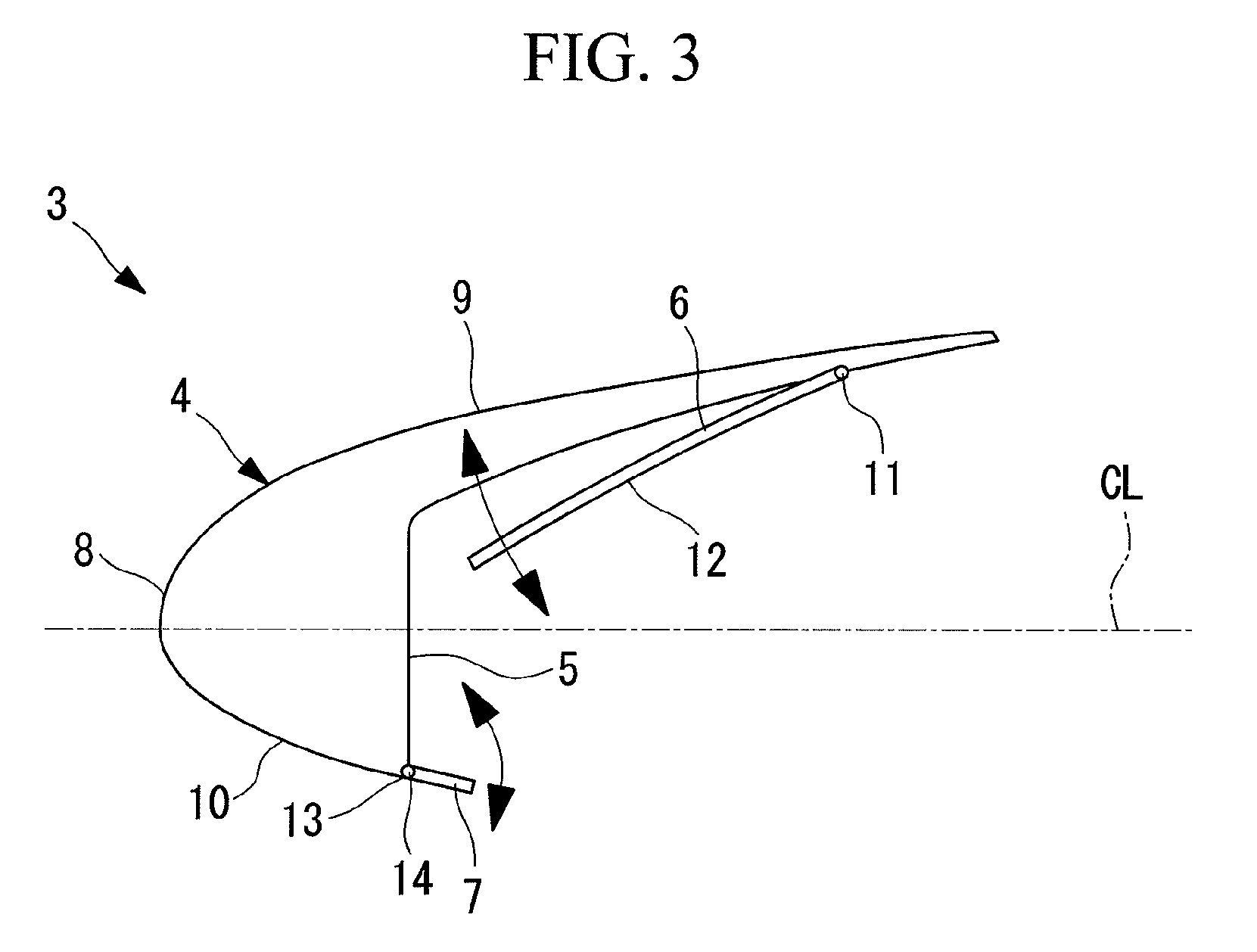High-lift device, wing, and noise reduction structure for high-lift device
a high-lift device and noise reduction technology, applied in the direction of fuselage, airflow influencer, fuselage insulation, etc., can solve the problems of structural (spatial) problems, increased airframe weight of the aircraft, and structural problems, so as to suppress the occurrence of aerodynamic noise, reduce noise, and suppress the collision
- Summary
- Abstract
- Description
- Claims
- Application Information
AI Technical Summary
Benefits of technology
Problems solved by technology
Method used
Image
Examples
first embodiment
[0095]A wing according to a first embodiment of the present invention will be described with reference to FIGS. 1 to 15.
[0096]FIG. 1 is a view for explaining an outline of the wing according to this embodiment and is a partial enlarged view for explaining a state where a slat is retracted. FIG. 2 is a partial enlarged view for explaining a state where the slat is extended in the wing shown in FIG. 1.
[0097]As shown in FIGS. 1 and 2, a wing 1 includes a main wing 2 and a slat (high-lift device) 3.
[0098]The main wing 2 is a member constituting the wing 1 together with the slat 3. The main wing 2 is formed to have an airfoil section to realize required aerodynamic characteristics when the slat 3 is retracted to serve as the wing 1 and when the slat 3 is extended to serve as the paired main wing 2 and slat 3.
[0099]The slat 3 is disposed at the leading edge of the main wing 2. A drive mechanism (not shown) that retracts and extends the slat 3 is provided inside the main wing 2.
[0100]Note ...
second embodiment
[0180]Next, a second embodiment of the present invention will be described with reference to FIGS. 16 to 20.
[0181]Although the basic structure of a wing of this embodiment is the same as that of the first embodiment, the structure of a noise reduction structure in a slat is different from that of the first embodiment. Therefore, in this embodiment, only the slat and the components surrounding it will be described with reference to FIGS. 16 to 20, and a description of the main wing etc. will be omitted.
[0182]FIG. 16 is a cross-sectional view for explaining the structure of the slat according to this embodiment. FIG. 17 is a cross-sectional view for explaining the structure of an airflow control part shown in FIG. 16. FIG. 18 is a cross-sectional view for explaining a structure for mounting the airflow control part shown in FIG. 17 to the slat.
[0183]Note that the same reference symbols are given to the same components as those of the first embodiment, and a description thereof will be...
third embodiment
[0219]Next, a third embodiment of the present invention will be described with reference to FIG. 24.
[0220]Although the basic structure of a wing of this embodiment is the same as that of the second embodiment, the structure of a noise reduction structure in a slat is different from that of the second embodiment. Therefore, in this embodiment, only the slat and the components surrounding it will be described with reference to FIG. 24, and a description of the main wing etc. will be omitted.
[0221]FIG. 24 is a cross-sectional view for explaining the structure of an airflow control part according to this embodiment.
[0222]Note that the same reference symbols are given to the same components as those of the second embodiment, and a description thereof will be omitted.
[0223]As shown in FIG. 24, the slat 3 of a wing 201 includes the slat main body 4, the cove 5, and an airflow control part (noise reduction structure) 206.
[0224]The airflow control part 206 suppresses the turbulence.
[0225]The...
PUM
 Login to View More
Login to View More Abstract
Description
Claims
Application Information
 Login to View More
Login to View More - R&D
- Intellectual Property
- Life Sciences
- Materials
- Tech Scout
- Unparalleled Data Quality
- Higher Quality Content
- 60% Fewer Hallucinations
Browse by: Latest US Patents, China's latest patents, Technical Efficacy Thesaurus, Application Domain, Technology Topic, Popular Technical Reports.
© 2025 PatSnap. All rights reserved.Legal|Privacy policy|Modern Slavery Act Transparency Statement|Sitemap|About US| Contact US: help@patsnap.com



